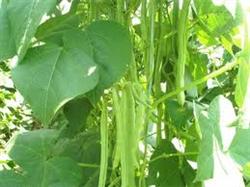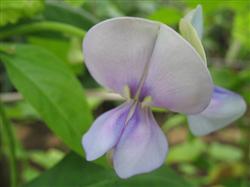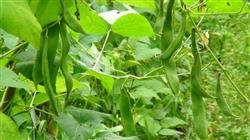Key points of efficient cultivation of cucumber interplanting kidney bean

Core tip: in mid-January, sow kidney beans 15 cm away from the cucumber row, or raise seedlings in a nutrition bowl and transplant them. The row spacing of kidney bean is 55 cm and the plant spacing is 50 cm. Kidney bean selected Wujin No.1, 851-923 and other excellent disease-resistant varieties, single plant colonization. Interplanting kidney bean with cucumber in solar greenhouse is a cultivation method with high yield and high efficiency. in Northeast China, the output value per mu can reach 12000-13000 yuan, which is welcomed by vegetable farmers. The main points of its cultivation are briefly introduced as follows. 1. Cultivation and management of cucumber 1. The bed soil is prepared to prepare 15 kilograms of high-quality farm manure per square meter in July. After it is fully mature, it will be laid in the greenhouse in the middle of September for hanging ploughing or raking, so that the organic fertilizer can be evenly mixed in the soil. Before planting, diammonium phosphate 60 g / m2 and potassium sulfate 30 g / m2 were used as base fertilizer. two。 Excellent varieties of cucumber such as Jinzao 3, Luning 1 and Xin A were selected. Yunnan black seed pumpkin is used as rootstock. 3. The cultivation of grafted seedlings first raised cucumber seedlings in early October, and then sowed black-seeded pumpkins when the cotyledons of cucumber seedlings flattened. One week later, when the cotyledons of black-seeded pumpkin seedlings flattened and the real leaves were just exposed, the grafting began. The natural temperature in mid-October is very suitable for wound healing. The seedlings were planted immediately after grafting, with small row spacing of 55 cm, large row spacing of 85 cm and plant spacing of 35 cm. This is beneficial to intercropping with kidney beans. After the grafted seedlings were planted, the grafted seedlings should be shaded and moisturized with a small arch shed. After 4-5 days, the seedlings were ventilated with a small arch shed. After about half a month, the cucumber roots were cut off and the hanger was carried out, then normal management was carried out. 4. In the mid-term management of cucumber, the irrigation times of melon seedlings should be reduced in winter, and the irrigation under plastic film or micro-irrigation should be adopted. 30 g / m2 of nitrogen, phosphorus and potassium compound fertilizer was applied before each irrigation. Pay attention to ventilation and dehumidification after irrigation. In order to prevent the occurrence of diseases, Chlorothalonil or Sukeling can be fumigated at night, which can effectively prevent the occurrence of downy mildew, Botrytis cinerea and other diseases. At the same time, foliar fertilizer can be sprayed appropriately in order to increase yield. Cucumbers were harvested at the end of December and were put on the market in large quantities before the Spring Festival. Second, the management of the symbiotic period of cucumber and kidney bean in mid-January, kidney beans were sown in the cucumber row 15 cm away from the cucumber row, or planted in a nutrition bowl. The row spacing of kidney bean is 55 cm and the plant spacing is 50 cm. Kidney bean selected Wujin No.1, 851-923 and other excellent disease-resistant varieties, single plant colonization. When the third group of kidney bean leaves were formed and pinched, the lateral branches were promoted to germinate and the overgrowth was controlled. When the second group of leaves of lateral branches were formed, they were pinched to promote the third branch, which laid the foundation for high yield. During the symbiotic period, the lower low functional leaves of cucumber were cut off in time to improve the permeability and create favorable conditions for cultivating strong kidney bean seedlings. Cucumber and kidney bean symbiosis for about 2 months, according to cucumber seedling status, cucumber price and kidney bean seedling growth and other factors, flexibly determine the time to pull out cucumber seedlings. Third, kidney bean management after pulling cucumber seedlings, the kidney bean rack hanging rope together to improve the lighting conditions between the shelves. Kidney beans blossom and bear pods in late March and begin to show off at the same time. According to the growth of kidney bean, apply appropriate amount of urea and potassium dihydrogen phosphate alternately, combined with foliar fertilization. Kidney bean entered the peak podding period in mid-April, with dense branches and leaves, and high temperature often appeared in the greenhouse. It is necessary to increase ventilation, regulate appropriate temperature and humidity, and prevent flowers and pods from falling. The main disease of kidney bean in greenhouse is Botrytis cinerea, which can be controlled by carbendazim, and the main pests are leaf miner and whitefly, which are fumigated with Miaojing, Aifuding, Yizuanjing and other pesticides, and the control effect is very good. Kidney beans can be harvested until the end of June.
- Prev

Technical points of interplanting kidney beans in cotton field
First, to select improved varieties, we should choose varieties with wide adaptability, strong stress resistance, high pod setting rate and high yield. Second, when sowing and cultivation at the right time, we should grasp the appropriate sowing time and choose full and glossy seeds to make the plant growth and development in a good environment, reduce flowers and pods and improve.
- Next

Control techniques of kidney bean retting root disease in protected area
The suitable planting areas of white kidney beans in Shangri-La County are Hutiaoxia Town, Jinjiang Town, Shangjiang Township, Wujing Township, Sanba Township and Luoji Township along the Jinsha River. These areas are backed by mountains and have a beautiful environment. No industrial and mining "three wastes" pollution, far away from towns, the soil is mostly red brown soil, oil sandy soil.
Related
- The first cup of black tea in spring, the flavor and history of tea gardens in Kenya, Africa
- The computer can not only choose potatoes, but also grow tea rice. AI will grow winter oolong tea champion.
- It is not only the inflated tea bitten by insects, but also engraved with the four seasons tea in Beipu.
- The Oriental Beauty Tea Festival in Zhuxian County takes the stage at the weekend to experience the plus-size feast of oil tea.
- & quot; Oriental Beauty Tea & Exploration of Emei in Hsinchu, the hometown of quot;
- The new variety of strawberry "Tainong 1" dessert is the first choice with mellow aroma. Crimson gorgeous
- History of Tea in Taiwan: from Wild Inner Mountain to Export Tea Garden
- Two types of Taiwan Oriental Beauty Black Tea won the British three-Star Award for Childhood Tea Xiang Zhang Jiaqi changed from pilot to champion tea maker.
- Banana species and varieties: the planting history of Taiwan Xianren banana and dwarf banana is long, is banana disease resistant?
- Coffee planting Technology: Qianjie Coffee from Seedling to harvesting

